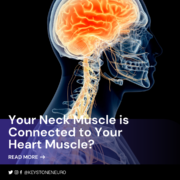
Similar Article:
The Pain is in my back, why are you looking at my neck?
For decades, upper cervical chiropractors have looked to the neck as a primary source and cause of low back related symptoms like sciatica. While this has had many patients and other doctors skeptical of effects that a gentle neck adjustment can have on the lower back, the stories of thousands of upper cervical patients getting relief from an atlas correction can speak volumes for a low back patient.
This is often amplified by the fact that most back pain patients don’t usually see an upper cervical chiropractor as their first option. Typically they’ve seen orthopedists, acupuncturists, and more traditionally trained chiropractors, who do a great job and provide relief for the vast majority of back pain patients.
If you’ve been through these different avenues and still have pain, it’s usually because positioning of the neck has largely been ignored. After all, why would someone with back pain need to have their neck worked on?
2015 Evidence of Neck Influence on Sciatic Pain
Earlier this year, research was published in the Journal of Manipulative and Physiologic Therapeutics that addresses the effect that anterior head syndrome has on sciatic pain. Anterior head syndrome is one of the Primary Conditions we see in our office on a daily basis, because it’s tied to so many different Secondary Conditions.
What is anterior head syndrome? It’s defined by the consequences that a head that’s shifted too far forward. This includes:
- Center of the skull displaced 40mm or greater in front of the lowest neck vertebra
- Muscular fatigue of the posterior neck muscles
- Abnormal postural compensation by the shoulder and pelvic girdles
- Early onset degeneration of the cervical discs.

So what did these researchers find?
The Effect of adding forward head posture corrective exercises in the management of lumbosacral radiculopathy: a randomized clinical trial
The authors looked at 154 adult patients who had forward head posture (different name for anterior head syndrome) and chronic disc related sciatic pain.
- Control Group: Patients received usual care for functional restoration including exercises for the hips and low back, cognitive behavioral therapy for pain modulation, and stress managment techniques
- The Experimental group received the usual care for functional restoration as well as neck exercises and stretches designed to reduce forward head posture.
Both groups showed similar improved in pain scale and improvement of firing of the S1 Nerve root after 10 weeks.
However, at a 2 year follow up the group that had their anterior head syndrome corrected maintained their improvement while the control group began regressing to their previous pain levels.
Not Just Back Pain, But Scoliosis Too
Of course we can’t just base this type of thing on one study. In 2012, researchers studied the effect of anterior head syndrome on scoliosis. You can see that abstract below:
The role of forward head correction in management of adolescent idiopathic scoliotic patients: a randomized controlled trial.
This is not just a pain issue. When the head and neck shift forward, it has a global effect on the 3-Dimensional alignment parameters for spine as a whole.
Why the Neck?
Why is the head and neck so important in the management of the lower spine? We don’t have great answers on that yet, but researchers think it has to do with how the neck dictates posture for the whole body. The nerve endings that stem from the muscles and ligaments of the neck play a big role in your body’s ability to control posture.
If the neck fails to provide adequate input into the brain, then the brain fails to produce adequate input to the muscles of the spine and lower extremity. This leads to tilted or rotated pelvis, and poor angulation of the tailbone underneath the spine. It looks a little bit like this image below:

As the neck goes back to normal, we begin to see measurements in the hips, back, and pelvis go back to normal again.
What if I can’t exercise my neck right now?
There are a lot of patients with back pain and neck pain who cringe at the idea of moving their spine, nevermind putting through an exercise regiment. For these patients, it’s important to break the cycle of pain so that we can have you looking forward to moving your body again.
Fortunately, one of the great things about an Atlas Correction procedure is that it can substantially improve Anterior head syndrome even before exercises become integrated.
We have found that a combination of Atlas Correction procedures in the neck along with corrective exercise can have a rapid and dramatic change on the correction of anterior head syndrome.
When You’re Tired of Treating Your Back, Maybe It’s Time to Look at the Neck
Pain is often times a non-linear health problem. What that means is that we can’t just think of the area that hurts to look for the cause. Sometimes we have to take a step back and look at the big picture to have a true understanding of why the body isn’t working properly.
If repeatedly treating the back over and over again has failed to produce your desired outcome, then maybe it’s time to look elsewhere. That’s the core of a holistic view point. It’s not about being a crunchy hippie, it’s about seeing the big picture, and how changing one variable effects the entire structure.














